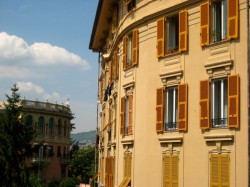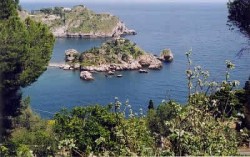ITALY CHRONICLES
Latest Posts
Listen to Italian Christmas music this Festive Season
If you’d like to add a little interest to this coming festive season, why not fill the atmosphere of your home, office or even Italian
Ferrari Gets a New Boss
Luca Cordero di Montezemolo is to leave the helm of Italian sports car maker Ferrari in mid-October. Rumours about the change had been flying around
Recent Events and Italy’s Ferguson
Last week was, as usual, rather hectic and peppered with announcements from Italy’s vociferous prime minister. Italy’s Prime Minister is forging ahead with announcements, if
The Barrista’s Bible – Espresso Coffee 2013: Tools, Techniques and Theory
1996 edition comments Excellent resource for coffee professionals and beginners. Most Practical Espresso book in the Market What a fantastic book for the experienced and
The Best Luxury Hotels in Milan
Maybe you are planning a long weekend or even planning to spend a week in Milan shopping to your hearts content. If so, then here
Ferrari Gets a New Boss
Luca Cordero di Montezemolo is to leave the helm of
Recent Events and Italy’s Ferguson
Last week was, as usual, rather hectic and peppered with
The Barrista’s Bible – Espresso Coffee 2013: Tools, Techniques and Theory
1996 edition comments Excellent resource for coffee professionals and beginners.
The Best Luxury Hotels in Milan
Maybe you are planning a long weekend or even planning
Italy

How Inefficient is Italy? Grossly.
Italy’s nightmarish bureaucracy and dysfunctional political system are legendary. Well, they do say there’s often more than a grain of truth in legends and the World Economic
Cinque Terre Floods
You may have heard that the popular tourist destination of the Cinque Terre, Liguria in Italy has been extensively damaged as a result of recent
Billionaire’s Beef
This post was inspired by this lovely little comment from a post over at Bleeding Espresso: Please let’s ignore the fact that Berlusconi has fooled a majority of Italians into voting him into office a third time, OK? And also that my local party lost as well. Instead let’s move on to happier, comforting topics. Like food.

How to Survive the Summer Heat in Italy
If you’ve read some of the other posts on this blog you may know about the heat which dominates Milan, and just about everywhere in Italy from around June until the end of September. Here’s what you can try to do to keep yourself from going mad and survive daily life in Italy in the heat of the summer season.
Exploring the Fascinating History of Italy during the Renaissance
The Renaissance was an extraordinary period in history characterized by a flourishing of intellectual and artistic achievements. It marked a significant departure from the Middle

Italy news updates from ItalyChronicles.com on Twitter via NewsfromItaly
Just to let you know that when BlogfromItaly.com is not being updated, @newsfromitaly – BlogfromItaly.com’s Twitter account most probably is. Via @newsfromitaly on Twitter you’ll hear the latest Italian news items, travel information, bits and bobs about Italian food and wine, as well as many other nuggets of Italy flavour information.
A Portable USB Charger – Just the thing for Your Trip to Italy
Having had problems myself, I can see that this Sony USB
The Seaside Pleasures of Nervi, Near Genoa, Italy
Not far from the northern Italian coastal city of Genoa, lies the scenic seaside suburb of Nervi. As Genoa lover Di Mackey, and a few others know, sleepy little Nervi has its attractions. My other half is from Genoa, and first took me to Nervi long ago. I liked it, and you might too.
Properties

How to Find Property for Rent in Italy
Maybe you are coming to Italy to work or study here for a while, in which case, you’ll need somewhere to live. If that’s the
House For Sale near Milan
Gaetano Salvo, friend and Blog from Italy researcher wants to sell his house. For those who might be interested, or may know of someone or

The Admirable Admiral’s Villa in Taormina
If you know your history pretty well, you may be aware that one of England’s most celebrated Admirals possessed a rather charming villa in the scenic Sicilian town of Taormina.

How to Find Property for Rent in Italy
Maybe you are coming to Italy to work or study here for a while, in which case, you’ll need somewhere to live. If that’s the

The Admirable Admiral’s Villa in Taormina
If you know your history pretty well, you may be aware that one of England’s most celebrated Admirals possessed a rather charming villa in the scenic Sicilian town of Taormina.
Places to stay in Italy
Casa Villatalla B&B, Liguria
By far the most important members of the Casa Villatalla household are Nellie (an elderly but loveable chocolate Labrador), Bonnie, a fluffy and rather scatty American Spaniel, and Pickle, aneccentric cat who walks like John Wayne.
Villa Miller Bed and Breakfast, Puglia, Italy
Located well off the main road in the depths of the Puglia countryside, Villa Miller the only sounds which disturb guests are those of the crickets and the ringing of the bells worn by the areas cow and sheep population.
Baur Bed and Breakfast, Acqui Terme, Piedmont
“You may have the universe if I may have Italy.“ – Giuseppe Verdi (1813-1901) Is the quotation which greets you when you visit the Baur B&B website, demonstrating how enchanting the owners find Italy.
Villa Miller Bed and Breakfast, Puglia, Italy
Located well off the main road in the depths of the Puglia countryside, Villa Miller the only sounds which disturb guests are those of the crickets and the ringing of the bells worn by the areas cow and sheep population.
Chaplin Bed and Breakfast Rome
Perfectly located in a safe and quiet but extremely central Rome neighborhood, the Chaplin Bed and Breakfast Rome is the ideal base for your Roman holiday.

